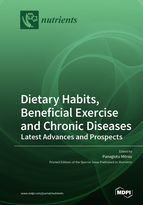Dietary Habits, Beneficial Exercise and Chronic Diseases: Latest Advances and Prospects
A special issue of Nutrients (ISSN 2072-6643). This special issue belongs to the section "Nutritional Epidemiology".
Deadline for manuscript submissions: closed (28 January 2022) | Viewed by 143327
Special Issue Editor
Interests: diabetes; glucose metabolism; lipid metabolism
Special Issues, Collections and Topics in MDPI journals
Special Issue Information
Dear Colleagues,
Several lines of evidence indicate that healthy diet and exercise can prevent cardiovascular diseases, stroke, diabetes, and some types of cancer such as colon cancer, and smoking-related cancers.
Dietary patterns defined as the quantities, proportions, variety, or combination of different foods and drinks, and the frequency with which they are habitually consumed are also associated with an increased or decreased incidence of chronic diseases.
Lately, an association has been found between eating habits, exercise, and psychological and/or mental disorders.
This Special Issue of Nutrients, entitled “Dietary Habits, Beneficial Exercise, and Chronic Diseases: Latest Advances and Prospects”, welcomes the submission of manuscripts, either describing original research or reviewing the scientific literature, focused on the relationship between dietary habits (macronutrients, micronutrients, drinks, meal frequency, etc.) and/or exercise with metabolic, cardiovascular, mental, rheumatic, infectious, neoplastic, odontostomatological, and other chronic diseases.
Dr. Panagiota Mitrou
Guest Editor
Manuscript Submission Information
Manuscripts should be submitted online at www.mdpi.com by registering and logging in to this website. Once you are registered, click here to go to the submission form. Manuscripts can be submitted until the deadline. All submissions that pass pre-check are peer-reviewed. Accepted papers will be published continuously in the journal (as soon as accepted) and will be listed together on the special issue website. Research articles, review articles as well as short communications are invited. For planned papers, a title and short abstract (about 100 words) can be sent to the Editorial Office for announcement on this website.
Submitted manuscripts should not have been published previously, nor be under consideration for publication elsewhere (except conference proceedings papers). All manuscripts are thoroughly refereed through a single-blind peer-review process. A guide for authors and other relevant information for submission of manuscripts is available on the Instructions for Authors page. Nutrients is an international peer-reviewed open access semimonthly journal published by MDPI.
Please visit the Instructions for Authors page before submitting a manuscript. The Article Processing Charge (APC) for publication in this open access journal is 2900 CHF (Swiss Francs). Submitted papers should be well formatted and use good English. Authors may use MDPI's English editing service prior to publication or during author revisions.
Keywords
- Eating
- Diet
- Nutrition
- Energy Drinks
- Exercise
- Diabetes
- Metabolic Diseases
- Cardiovascular Diseases
- Rheumatic Diseases
- Mental Disorders
- Odontostomatological Diseases







